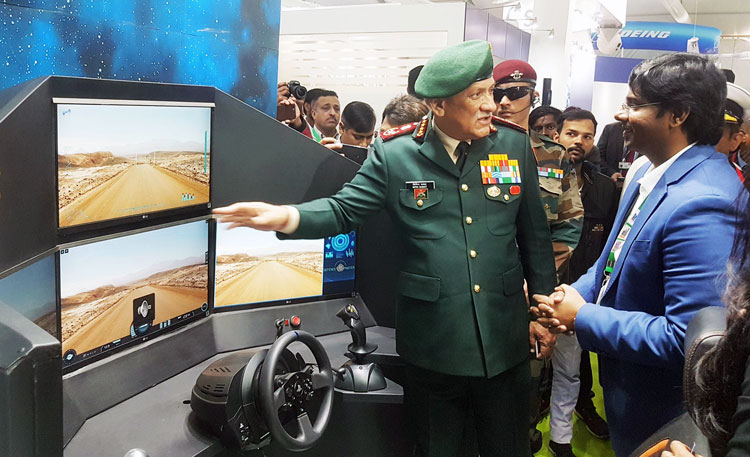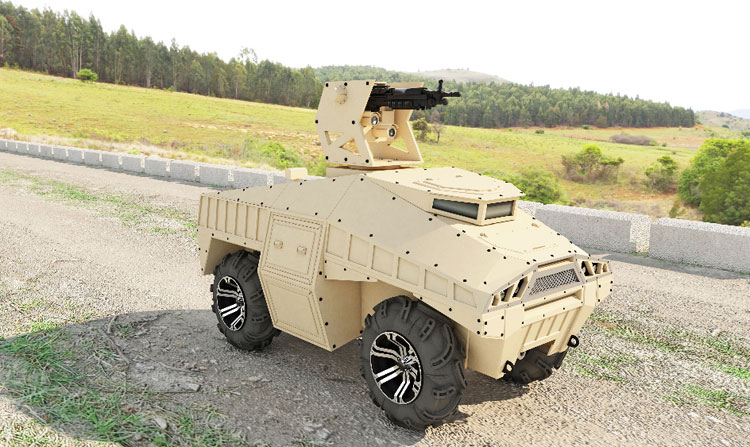INDIAN ARMED FORCES CHIEFS ON
OUR RELENTLESS AND FOCUSED PUBLISHING EFFORTS

SP Guide Publications puts forth a well compiled articulation of issues, pursuits and accomplishments of the Indian Army, over the years

I am confident that SP Guide Publications would continue to inform, inspire and influence.

My compliments to SP Guide Publications for informative and credible reportage on contemporary aerospace issues over the past six decades.
- Interim Defence Budget 2024-25 — An Analysis
- Union Defence budget 2024
- Indian Army: In quest of greater firepower and policy recommendations for gaps
- Indian Army Annual Press Conference 2024
- 6G will transform military-industrial applications
- Tata Boeing Aerospace Delivers 250 AH-64 Apache Fuselages, Manufactured in India
Indigenous Combat Robots
 |
The Author is Former Director General of Information Systems and A Special Forces Veteran, Indian Army |

During DefExpo 2020 held in February this year, Indian Start-up Company, Defence Master India Pvt Ltd, displayed ‘Sooran’, an indigenous combat robot, which according to the company is field tested, is ready to go into production and will be tested by the Indian Army during April 2020 in Chennai. Dennis Ebenezar, Managing Director of Defence Master India Pvt Ltd told media recently, “Sooran is field-tested and ready to go for manufacturing. We are still upgrading its autonomous capabilities and working on documentation works.” This is good news especially since Sooran is India’s first unmanned armoured vehicle, capable to fight on battlefields and can be operated from a distance, has caught the interest of the Indian Army.
Sooran is a multi-terrain armoured vehicle, equipped with artificial intelligence and runs on a petrol engine. It can be operated in three modes; tele-operated with remote, tele-operated from a mobile control station and through an autonomous mode. It also has onboard long-range cameras, high-end processors, controllers, sensors, power backup, etc. According to Ebenezar, “The unmanned vehicle weighing around 500 kgs can be operated either through a control room or through a mobile phone. It has a mounted gun turret, and this too can be controlled remotely.” The artificial intelligence used is named ‘Nivata’. Ebenezar, son of a retired schoolmaster, is presently engaged in refining functionalities of Nivata, which is under development and testing. He says, “We have three ground and air combat systems that are capable to conduct coordinated combat operation using Artificial Intelligence (AI). Nivata is specially designed to take on terrorists hiding inside buildings. And besides ‘Sooran’ which is Tele-operated Unmanned Combat Vehicle with Autonomous mode, there is ‘Sky Emperor’, Drone with a Gun. Remote controlled and Autonomous and ‘Scout Flies’ – a cluster of micro-drones used to destroy Specific targets using a small amount of chemical explosives loaded in it. ‘Scout Flies’ can also be used for mass ground search operations with facial and object recognition and is fully autonomous with pre-designed tasks. A demonstration is being scheduled for mid-April, where all the three combat systems will conduct a coordinated combat operation with the help of Nivata, with certain pre-designed assignments.

Sooran caught the interest of the Army during DefExpo 2020, as also the Chief of Defence Staff (CDS). It will be a boon in the future digitised environment and help minimise casualties in operations. The DRDO and HAL had also evinced interests in Sooran and Nivata. In March 2018, China had demonstrated 'Sohu', a Type 59 Main Battle Tank (MBT) platform being driven remotely by a soldier using an independent computer terminal with a steering wheel to control and drive it. This indicated that PLA has developed their first unmanned main battle tank. PLA had simultaneously also launched the development of unmanned vessel, fighter and combat helicopter. On April 8, 2019, China's Shipbuilding Industry Corporation (CSIS) delivered the armed amphibious drone boat 'Marine Lizard' to the PLA. The 12 metre long Marine Lizard is trimaran propelled by a diesel-powered turbojet and can reach a speed of 50 knots maintaining stealth. While approaching land, the amphibious drone can release four continuous track units hidden under its belly, and can travel at 20 km an hour on land. In February 2020, a Chinese company unveiled 'Mule-200’, a new versatile combat robot that can transport ammunition and supplies in difficult and complicated terrain or provide fire cover when armed during the Unmanned Systems and Conference 2020 (UMEX 2020) at Abu Dhabi. The Mule-200 is a medium-sized, multipurpose crawler UGV designed to accompany infantry units and transport ammunition and supplies, equip firearms and proved fire support at close range. Developed on the modular design concept, Mule-200 can switch loads for transport, reconnaissance, combat and communication relay for different missions. While other UGVs leave the loads in the open, Mule-200 stores the loads within its body having armour protection. With two caterpillar tracks, the Mule-200 can travel in all types of terrain. It can run at a top speed of 50 kmph to the longest range of 50 km carrying a maximum load of 200 kgs, weight of the robot itself being 500 kg. Combat robots will play an important role in the future battlefield given the improvements in precision guided and loitering ammunition which can cause more casualties to personnel and equipment.
The innovations of ‘Sooran’, ‘Sky Emperor’ and ‘Scout Flies’ demonstrate India has the capacity to catch up with in the race of combat robots, which will also be invaluable in counter insurgency and counter terrorist operations. Trials of these during April in Chennai will be keenly watched. The entire funding of the three innovations has been borne by Dennis Ebenezar. The challenge finally will be to speedily mass produce these combat robots and field them into the military.





